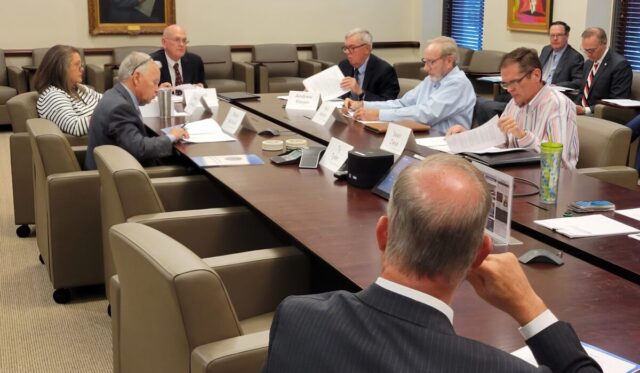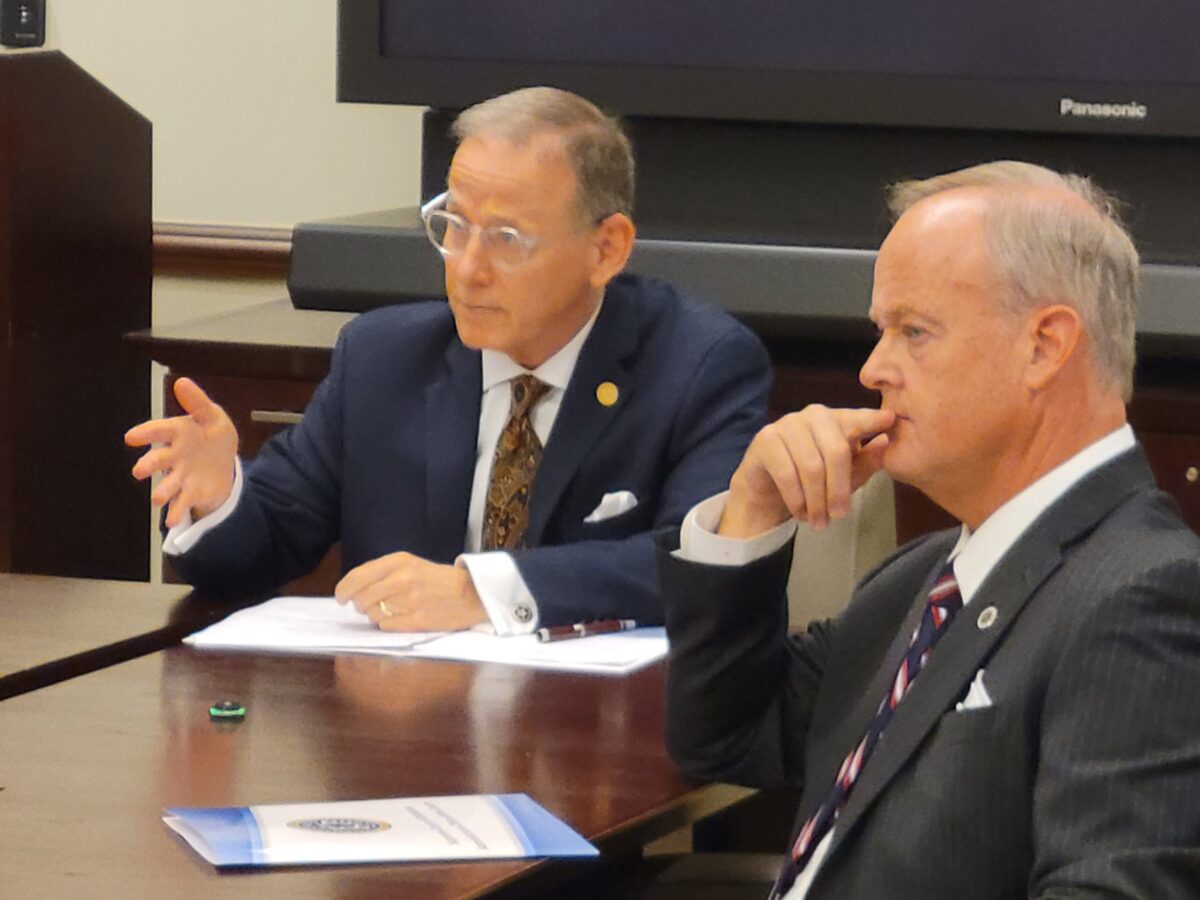
The Oklahoma Board on Judicial Compensation held its biannual meeting Tuesday and voted to recommend a 17 percent across-the-board pay raise for judges, which would take effect in 2024 unless modified or rejected by the Oklahoma Legislature next session.
The increase would range from about $29,490 for Oklahoma Supreme Court justices to about $26,664 for special district court judges. A chart is embedded below.
The increase would bring Oklahoma judges to roughly the regional average among Colorado, Arizona, Missouri, Texas, New Mexico and Kansas.
Altogether, the proposed increase for the Supreme Court, Court of Civil Appeals, Court of Criminal Appeals and district, associate and special judges would carry an estimated price tag of more than $8.5 million. The 17 percent increase would range individually from $22,505 (special district judges) to $31,492 (chief justice) a year.
Unless the governor or the Legislature strikes them, the raises will take effect July 1, the start of the next fiscal year. The last pay raise for judges took effect in 2022 after the Board on Judicial Compensation recommended a 7.67 percent raise.
The Board of Judicial Compensation was created by the Legislature in 2004 to review compensation in odd years. Ultimately, legislators and the governor have the option to amend or reject the recommendation.
Board members Tuesday discussed the matter for more than 90 minutes, hearing from among others Supreme Court Chief Justice M. John Kane IV, Court of Criminal Appeals Presiding Judge Scott Rowland, McAfee & Taft shareholder Michael Lauderdale, Cleveland County District Judge Thad Balkman and Oklahoma County District Judge Richard Ogden.
All asked the board — made up of two gubernatorial appointees, four legislative appointees and a designee of the chief justice — to recommend a judicial pay raise in an effort to attract more and better applicants and candidates for judicial positions.
Lauderdale, representing law firms in the state, asked the board to consider a 17 percent increase.
“We have a great judicial bench in Oklahoma,” he said. “I want to keep it that way.”
The board was mostly receptive.
“We should do all we can,” said board member Mark Nichols, of Altus, who was reappointed this year by Kane. But Nichols conceded that a 17 percent pay increase “may sound like a lot.”
Sean Ziese, an appointee of Gov. Kevin Stitt from Park Hill, said it has been difficult after the COVID pandemic for businesses to attract and retain employees. He has given 19 percent pay raises to keeps employees, he said.
“We need good people on the bench, definitely,” he said.
Board Secretary Sheryl Lovelady, appointed by Senate President Pro Tempore Greg Treat (R-OKC), said it’s important for Oklahoma to keep judicial pay competitive. Higher pay in the private sector and rising costs make it difficult to get and keep judges on the bench.
For example, the price of concrete went up 11 percent from May to September, she said.
“We’re all in a state of sticker shock,” Lovelady said.
The board, with one member absent, voted 5-0 to recommend the 17 percent increase. Board Chairman David Pitts, of Stillwater, abstained.
He said the judiciary should be fairly compensated, but based on what he’s seen in raises in the public and private sectors, “that’s probably going to be on the high side,” said Pitts, who was appointed to the board by Treat.
“We should be mindful that their compensation is probably never going to match their duties,” he said. “They have to have a public-service component for what they do. I just don’t know if we can outpace or try to even. I think we’re going to be leading the region, and I don’t think we can be in a position to lead the region.
“I think we’ll be well above the average right now, but the problem is we don’t know what the other states are going to do,” Pitts said.
Double-digit increases are recommended rarely. In 2005, the board recommended and legislators approved an average increase of 15 percent for the judiciary, with the chief justice receiving a 19 percent increase, boosting his salary from $117,000 to $140,000.
“The Legislature will go through their due diligence and probably review our findings and determine whether or not they agree with it,” Pitts said after the meeting. “That’s their prerogative.”
During this year’s regular session, House Appropriations and Budget Chairman Kevin Wallace (R-Wellston) authored HB 1022X, purportedly as a part of the House’s budget agreement with the Senate. The bill proposed creating a new “judicial performance evaluation” program, including private feedback from attorneys and case parties that would be reviewed by an appointed board.
The Senate, however, voted down the judicial performance evaluation proposal 15-29. All attorneys in the Senate voted in favor of the bill, except Sen. Julie Daniels (R-Bartlesville).
Considering Wallace’s strong desire to create a judicial evaluation system, the topic could become tied to the Legislature’s judicial pay decision in 2024.
Oklahoma judicial salaries among lowest in region

In their capacities as leadership of the Oklahoma Judges Association, Balkman and Ogden presented information Tuesday that said even with the 2022 pay raise recommended by the board and funded by the Legislature, Oklahoma’s judicial salaries are the lowest of surrounding states. Oklahoma ranks 45th in the nation.
Since 2021, Kansas, Colorado, Missouri and Arkansas increased judicial pay, they said. Beginning January 2025, district judges in Kansas will earn $183,521 annually, up from $148,912.
The federal government pays much more than Oklahoma in judicial pay, even though more than 90 percent of all civil and criminal cases are filed and litigated in a state court, Balkman and Ogden said. State trial judges do not have law clerks like their counterparts to help manage their caseload.
The Oklahoma Judges Association surveyed dozens of private practice attorneys across Oklahoma and found that attorneys with 12 to 14 years in practice can expect to make $250,000 to $300,000 or more, plus incentive bonuses. Law school grads starting at a big firm can expect to be paid anywhere from $75,000 to $125,000 a year, plus performance incentives.
District judges in Oklahoma are paid $156,732 a year; associate district judges are paid $144,559; and special judges are paid $132,385 a year.
Ogden said he was a practicing attorney for 24 years before being appointed to the bench in Oklahoma County, a career-long goal. He was named a special judge in 2015, and in 2017 he was appointed a district judge.
In 2017, he was one of 17 to apply for the open Oklahoma County District Court position. Three years ago, only five attorneys applied for a vacant district court position in Oklahoma County. In Oklahoma, attorneys apply when a judicial vacancy occurs. The Judicial Nominating Commission selects three to recommend to the governor, who makes the appointment.
Judges have speculated about the fewer judicial applicants and what effect it would have on filling vacancies, he said.
“Now we see it actually happening,” Ogden said.
Kane said compensation and a large workload are two factors why fewer attorneys are applying to fill judicial vacancies. Only five applied for a judicial vacancy in the Altus area, five applied for a vacancy in Tulsa, and six applied for a vacancy in Cleveland County.
The larger judicial districts should attract more than five or six candidates, he said.
It’s also becoming more difficult for judges to stay on the bench, Kane said. A judge resigned just last month to take a higher-paying position.
“He couldn’t afford to keep judging in Oklahoma,” Kane said.
Past decisions by the Board on Judicial Compensation
After the attorneys and judges left, the board discussed inflation, regional averages, cost-of-living differences and historical pay-raise recommendations that were cut in half by lawmakers.
In September 2019, the board had recommended a 9 percent increase for all judges. But during the 2020 legislative session, economic uncertainty related to negative petroleum prices and other pandemic problems led lawmakers to consider killing the entire pay raise recommendation.
They eventually chose to approve only half of the suggested pay raise, a 4.5 percent hike that also triggered subsequent pay increases for district attorneys, court clerks and other public employees.
In 2013, the board recommended a 12 percent increase for the judiciary and legislators approved a 6 percent increase. In 2015, the chief justice at the time asked for no judiciary increase because Oklahoma was in an economic downturn.
In 2017, the board recommended, and legislators approved, a 6 percent increase to fill the balance of the 12 percent increase recommended four years earlier.
Proposed 17 percent judicial pay raise
